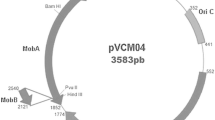Abstract
The complete plasmid QpH1 fromCoxiella burnetii, isolate ‘Nine Mile’, phase I, was cloned asNotI fragment with a size of 37329 bp. The entire plasmid was sequenced by the chain termination method afterEcoRI subcloning. 37 open reading frames coding for polypeptides larger than 100 amino acid residues were determined. The predicted polypeptide products of the open reading frames were compared by computer analysis with reported protein sequences. Homologies of predicted polypetide products to analogous proteins are described.
Similar content being viewed by others
References
Raoult D. Treatment of a fever. Antimicrobiol Agents Chemother 1993; 37: 1733–1736.
Raoult D. Host factors in the severity of Q fever. In: Rickettsiology: Current issues and perspectives. Ann NY Acad Sci, 1990; 590: 33–38.
Frazier ME, Mallavia LP, Samuel JE, Baca OB. DNA probes for the identification ofCoxiella burnetii strains. In: Rickettsiology: Current issues and perspectives. Ann NY Acad Aci, 1990; 590: 445–458.
Mallavia LP, Samuel JE. Genetic diversity ofCoxiella burnetii. In: J. Moulder, ed. Intracellular parasitism. CRC Press, 1989: 117–126.
Mallavia LP, Samuel JE, Kahn ML, Thomashow LS, Frazier ME.Coxiella burnetii plasmid DNA. Microbiology 1984, 293–296.
Savinelli EA, Mallavia LP. Comparison ofCoxiella burnetii plasmids to homologous chromosomal sequences present in a plasmidless endocarditis-causing isolate. In: Rickettsiology: Current issues and prspectives. Ann NY Acad Sci 1990; 590: 523–533.
Thiele D, Willems H, Köpf G, Krauss H. Polymorphism in DNA restriction patterns ofCoxiella burnetii isolates investigated by pulsed field gel electrophoresis and image analysis. Eur J Epidemiol 1993; 9: 419–425.
Willems H, Thiele D, Krauss H. Plasmid based differentiation and detection ofCoxiella burnetii in clinical samples. Eur J Epidemiol, 1993; 19: 411–418.
Myers WF, Baca OG, Wisseman CL, Jr. Genome size of the rickettsiaCoxiella burnetii. J Bacteriol 1980; 144: 460–461.
Samuel JE, Frazier ME, Kahn ML, Thomashow LS, Mallavia LP. Isolation and characterization of a plasmid from phase ICoxiella burnetii. Infect Immun. 1983; 41: 488–493.
Samuel JE, Frazier ME, Mallavia LP. Stability of plasmid sequences in an acute Q-fever strain ofCoxiella burnetii. J Gen Microbiol, 1988; 134: 1795–1805.
Samuel JF, Frazier ME, Mallavia LP. Correlation of plasmid type and disease caused byCoxiella burnetii. Infect Immun 1985; 49: 775–779.
Samuel JE. Correlation of isolate grouping and disease caused byCoxiella burnetii. Ph D Thesis. Department of Microbiology, Washington State University, Pullman, WA, 1986.
Valková D. The study of plasmid types ofCoxiella burnetii. Ph D Thesis. Slovak Academy of Sciences, Bratislava, Slovak Republic (in Slovak, Summary in English), 1993.
Ning Z, Shu-Rong Y, Quan YG, Xue Z. Molecular characterization of cloned variants ofCoxiella burnetii isolated in China. Acta Virol 1991; 35: 173–183.
Sawadogo M, Van Dyke MW. A rapid method for the purification of deprotected oligodeoxynucleotides. Nucleic Acid Res 1993; 39: 674.
Minnick MF, Small CL, Frazier ME, Mallavia LP. Analysis of the cbhE' plasmid gene from acute disease-causing isolates ofCoxiella burnetii. Gene 1991; 103: 113–118.
Weisburg WG, Dobson ME, Samuel JE, Dasch GA, Mallavia LP, Baca OG, Mandelco L, Sechrest JE, Weiss E, Woese CR. Phylogenetic diversity of the rickettsiae. J Bacteriol 1989; 171: 4202–4206.
Farinha MA, Ronald SL, Kropinski AM, Paranchych W. Localization of the virulence-associated genes pilA, PilR, rpoN, fliA, fliC, ent, and fbp on the physical map ofPseudomonas aeruginosa PAO1 by pulsed-field electrophoresis. Infect Immun 1993; 61: 1571–1575.
Sokol PA, Woods DE. Demonstration of an ironsiderophore-binding protein in the outer membrane ofPseudomonas aeruginosa. Infect Immun 1983; 40: 665–669.
Sokol PA, Woods DE. Antibody inhibition of ferripyochelin binding toPseudomonas aeruginosa cell envelopes. Biochemistry 1984; 3: 5076–5080.
Sokol PA, Woods DE. Characterization of antibody to the ferripyochelin-binding protein ofPseudomonas aeruginosa. Infect Immun 1986; 51: 896–900.
Sokol PA, Woods DE. Monoclonal antibodies toPseudomonas aeruginosa ferripyochelin-binding protein. Infect Immun 1986; 53: 621–627.
Sokol PA. Surface expression of ferripyochelinbinding protein is required for virulence ofPseudomonas aeruginosa. Infect Immun 1987; 55: 2021–2025.
Author information
Authors and Affiliations
Rights and permissions
About this article
Cite this article
Thiele, D., Willems, H., Haas, M. et al. Analysis of the entire nucleotide sequence of the cryptic plasmid QpH1 fromCoxiella burnetii . Eur J Epidemiol 10, 413–420 (1994). https://doi.org/10.1007/BF01719665
Accepted:
Issue Date:
DOI: https://doi.org/10.1007/BF01719665



